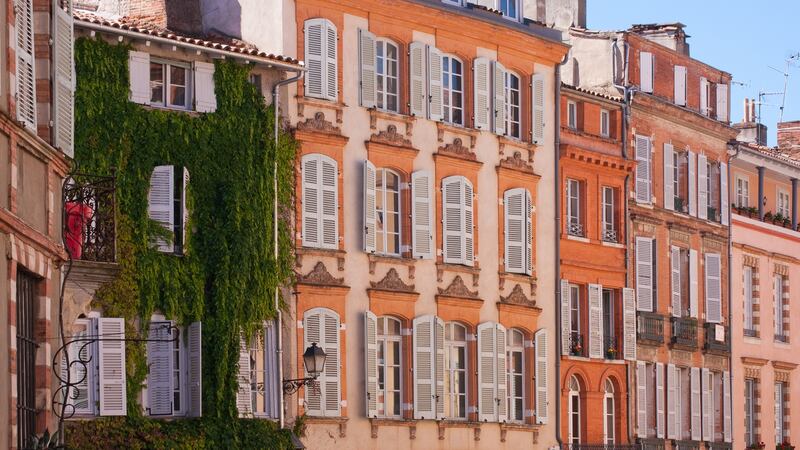Compared with the architectural splendour of Paris and the palm tree boulevards of Nice, Toulouse’s beauty doesn’t spill out onto the streets. It’s most often hidden behind closed doors.
Celine, my local in the know, strides down Rue Sainte-Ursule – a narrow street in Toulouse’s old town precariously shared by pedestrians, cyclists and cars – pushes a double-heighted double door and disappears through. It leads to the courtyard of a hip co-working space, but we’re here to peruse the courtyard itself; an ivy-filled oasis of calm surrounded by ivy-framed buildings.
These courtyards are a common sight in the old town, speaking of Toulouse’s glory years as a booming place trading in pastel, or “blue gold” – the plant that was used to dye clothes in the 16th and 17th centuries.
For a city dubbed “la ville rose” because of its famous pinkish bricks, it owes a great deal to the blue stuff. The mansions have since changed into modern hotels, offices and private apartments, but these preserved courtyards remain, and the informal rule seems to be that if a door is open, you can pop your head in.
"Some places, they keep their doors shut, and that's their right," Celine shrugs and repeats, in a way that suggests she thinks otherwise. In any case, these great houses are being considered for Unesco status; if they are granted it, public access will be enforced.
In the meantime, it’s easy enough to stumble upon them. I spend a balmy summer’s afternoon in the well-kept courtyard of Hotel La Cour des Consuls catching up with my travel buddy Sinéad – who’s back from New York for a spell – over coffee and petit fours. It’s the finale of a sublime lunch at its adjoining restaurant, Le Cenacle, one of 12 Michelin-starred restaurants in the city (a myriad more jostle for a place on the list, which still holds great value in its native country).
Happily for us, Toulouse seems especially suitable for meandering talks, the nursing of wine, and long stretches of riverside walking. Everything runs at an unhurried pace. Even the farmer's market on Boulevard d'Arcole feels relaxed as women with life-lined faces inspect precarious pyramids of plums, figs and artichokes. They are joined by bargain-hunting students, who make up one in six of its population.
People-watching seems to be as popular here as in Italy, and we make the most of this culture. At night, we avoid the busy Place du Capitole and join the local chatter in Place Saint George instead. A bottle of Languedoc red and French tapas (hybrid menus that hint at Toulouse’s proximity to Spain) last the course of a long, heady night. Throughout the year, the weather doesn’t hinder these languid evenings for locals: mist sprays are wheeled out on hotter days, and on frosty days, heaters take their place.
L’architecture
Our mornings are spent mooching in les vieux quartiers as it wakes up. Grittier than the toy old towns of more tourist-focused cities, the maze of roads are narrow and uneven, so that walking is a constant trip hazard. But there are plenty of sights of note around them.
For example, it’s hard not to be endeared by the few remaining 16th century wooden buildings, like the rickety one on the corner of Rue Peyras (also marked down as Carrièra Peiràs, a nod to Toulouse’s location in the Occitan-speaking region of Europe).
The heart of Toulouse is the Capitole, the city’s main public building, part of which is open to all free of charge if there’s no wedding on the go.
St Sernin is the most famous church, a fine example of Romanesque architecture, which holds relics of St Saturnin, Toulouse’s patron saint (the story of how he was tethered to a bull and dragged around is a common motif across the city).
But my favourite buildings differ. The Cathedral St Etienne is a mish-mash marvel; it’s an older southern Gothic church later eclipsed by its northern Gothic extension; the two sections most certainly do not blend, and I love it for its strangeness. Then there’s the Church of the Jacobins, simple and sleek in design, with contemporary stained-glass windows in the place of the originals (dark fact of the day: these were removed during the Napoleonic Wars so the lead could be reused for ammunition).
Yet Toulouse isn’t a city that only trades on its past – with her New York frame of mind, Sinéad finds much to appreciate. These same trip-hazardy streets are lined with contemporary shops: Toulouse specialises in concept stores, cute independent shops that sell clothes alongside handmade jewellery, cool gifts and designer furnishings.
There’s an air of creativity all over the city – if it’s not within these stores, it’s in the street art, or in the remnants of an old church stuck randomly on empty walls to keep them interesting.
I step into jewellery supplies store Fifi Jolipo to see if they can fix a broken earring. I step out an hour later with three necklaces I made myself with no prior experience, and good-as-new dangly earrings – all for €14 and a little manual labour.
There are marvellous galleries too. Across the river Garonne, Les Abattoirs houses an abundant permanent collection and interesting exhibitions. During our visit, it’s on Picasso and the Spanish Exodus, culminating in Guernica – to these eyes, the most powerful piece of art in existence. Bravo, Toulouse.
Les vins
Today, France’s fourth-largest city benefits from thriving businesses in its environs. It’s part of the country’s Aerospace Valley, famous for aeronautic research, design and engineering, with aviation museum Aeroscopia and space travel attraction La Cité de l’Espace open for visits.
Toulouse is also known for its excellent wine, only to be expected in the Languedoc-Roussillon region. If we had more time we'd have headed out to one of the vineyards, but instead our wine tastings are confined to the city.
Sinéad arrives earlier in the day, and greets me at our hotel, the comfortable Hôtel Mermoz, with a bulbous glass of house red and a grin that suggested she’d just won the lottery. Nearly. “It’s €3.50 a glass! A glass!” It doesn’t taste like it should be in that price bracket – it’s dark, smoky, tanniny, but with a remarkably smooth finish.
For comprehensive research, we make a beeline to the much talked-about No 5 Wine Bar. It has a plaque outside declaring it the “Best Wine Bar in the World” but stepping into the cramped shop, with uncomfortable stools, plastic counters and bright lights upstairs and a decent looking cellar downstairs (it’s occupied by a corporate party, so I can only peek), the draw seems more about the wine than the decor: 500 rare and expensive bottles are available by the sample or glass.

I understand it’s a treat to try out the €300 2006 Sant’Antonio Amarone della Valpolicella without doing some budgetary damage, but also quickly realise that, for me, the flavours of wine are best brought out by a warm atmosphere, flowing conversation and personable service.
And so, after a final day exploring, neither of us object to going rogue and enjoying a low-key farewell drink at Bar Filochard, a sticky-floored dive with a prime riverside location in front of Pont Neuf. It has no plaques outside, and this time, the €3.50 wine isn’t a shining example. But the friendly, diverse crowd gathering on the streets as the setting sun floods us with its golden-orange hues, forms a lasting impression.
Perhaps Toulouse’s beauty does spill out onto the streets after all.
Shilpa Ganatra was a guest of Toulouse Tourism. Aer Lingus and Ryanair fly direct from Dublin to Toulouse. See toulouse-visit.com.



















